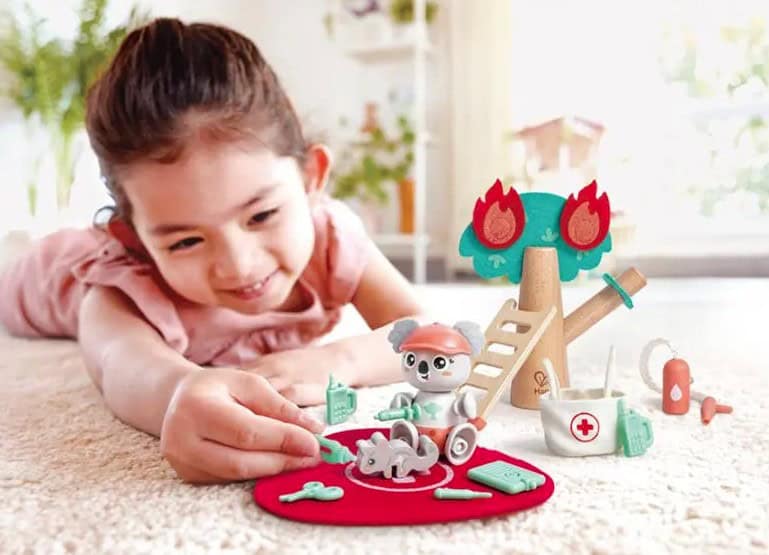Last Updated on June 1, 2024 by ellen
Check out these sustainable toys from Playmobil and Hape. Learn more about how to talk to children about Earth Day and toys they’ll enjoy.
Posts may be sponsored. This post contains affiliate links, which means I will make a commission at no extra cost to you should you click through and make a purchase. As an Amazon Associate I earn from qualifying purchases.
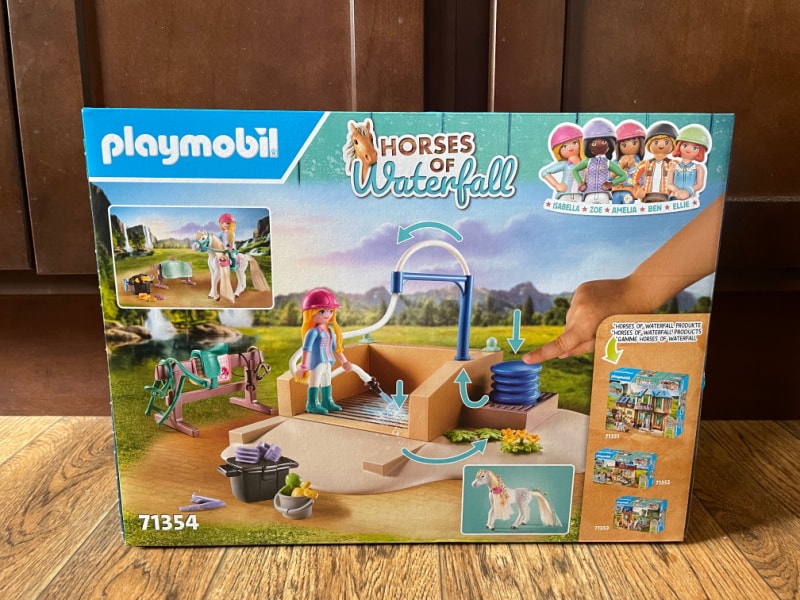
Table of Contents
Sustainable Toys from Playmobil and Hape
In a world where the environmental footprint of our choices has never been more critical, the way we play can have a profound impact. For eco-conscious parents and conscientious consumers alike, the phrase ‘sustainable toys’ resonates powerfully.
But what exactly are sustainable toys? How do they blend fun with eco-friendliness? And most importantly, how can sustainable toys weave a green thread through the tapestry of childhood, fostering not just play, but a lifelong appreciation for the environment?
Explore the world of sustainable toys, discovering brands that make Mother Nature proud, and sharing insights on enacting the spirit of sustainability in every toy box.
Print a copy of these Earth Day worksheets for kids.
The Meaning Behind Sustainable Toys
At their heart, sustainable toys are playthings produced with a thoughtful consideration of their impact on the environment. This intent is multi-faceted, branching into several key practices:
Materials Matter – Sustainable toys are crafted from eco-friendly, non-toxic, and often biodegradable materials. The goal is to minimize environmental harm without compromising on durability or safety.
Responsible Manufacturing – The production of sustainable toys prioritizes energy efficiency, waste reduction, and ethical labor practices. Brands focus on minimizing their carbon footprint throughout the production and supply chain.
Longevity and Learning – Sustainable toys are designed to be more than mere distractions. They often encourage open-ended play, creativity, problem-solving, and sometimes, even come with a built-in lesson on the importance of conservation.
End-of-Life Plan – A true testament to sustainability is in the toy’s disposal. Many sustainable toys are designed with recycling or upcycling in mind, reducing the burden on landfills and offering a second life after they’ve been outgrown.

Inspiring Eco-awareness through Play
In the gentle hands of a child, a toy becomes more than an object. It transforms into a storyteller, an artist’s tool, even a guide. Sustainable toys, with their ties to nature and eco-friendly design, act as the perfect medium to introduce young minds to the concept of environmental stewardship.
Role-Playing and Storytelling – Dollhouses, animal figures, and playsets can be used to introduce real-world scenarios, discussions about habitats, and the importance of respecting natural spaces.
Art and Creativity – Arts and crafts made with sustainable materials not only nurture a child’s artistic expression but teach about the variety in our natural world.
Hands-On Learning – Toy gardening kits, eco-science experiments, and renewable energy toys provide engaging, age-appropriate education about environmental issues and solutions.
Through these avenues, children can develop a sense of empathy and responsibility towards the planet, its flora, and fauna. Sustainable toys, in their uniqueness and limited footprint, become the embodiment of these teachings.
Check out these Miraculous toys!
Playmobil’s Path to Sustainability
Playmobil, a beloved toy brand known for its imaginative playsets, has embarked on a significant sustainability initiative. From the implementation of eco-friendly production processes to the creation of ‘green’ product lines, they’re taking meaningful steps to reduce their ecological impact.
Bio-based Plastic Toys – Playmobil’s ‘EverDreamerz’ and ‘Magic’ series mark a shift towards bio-based plastics, derived from sugarcane, that are 100% recyclable and promise a smaller carbon footprint.
Eco-Ambassador Sets – Sets like the ‘Café with Awning’ and ‘Electric Car’ encourage discussions around eco-living and the choices we make daily that can benefit the environment.
Recycled Packaging – The company is phasing in paper-based, biodegradable materials for packaging. This is part of their commitment to minimizing waste.
By integrating sustainable practices into the play experience, Playmobil offers parents and children a bridge between the imaginary world they create in play and the tangible actions they can take to preserve the world around them. Find them here.
Check out these summer toys.
My favorite Playmobil recycled toys
- WIltopia Cross Country Vehicle (ages 4-10)
- Country Farm Shop (ages 4-10)
- PLAYMOBIL Horses of Waterfall (ages 5-12)
Hape’s Commitment to the Planet
Hape is a leader in wooden toys. They have long been a proponent of sustainable play. Their dedication to quality wooden toys goes hand-in-hand with their commitment to protecting the environment.
FSC-Certified Wood – Hape uses wood from responsibly managed forests with certification from the Forest Stewardship Council (FSC). This ensures that the wood is sourced sustainably. And, it promotes biodiversity and protecting fragile ecosystems.
Eco-Friendly Finishes – The use of water-based paints and natural dyes on their toys marks a departure from the harmful chemicals in traditional toys. This not only reduces environmental pollution but also safeguards the health of children.
Long-Lasting Durability – Wooden toys are often more robust than their plastic counterparts, leading to a longer lifespan. Hape’s toys are designed for generations. This reduces the need for constant replacement and thus, reducing waste.
Hape’s commitment to sustainability through safe, natural materials and durable design is a testament to their belief that the best playthings are those that respect the Earth. Find them here.
My favorite Hape sustainable toys
- Forest Fire Rescue set (ages 3+)
- Ranger Rescue Set (ages 3+)
- Eco Camping Playset (ages 3+)
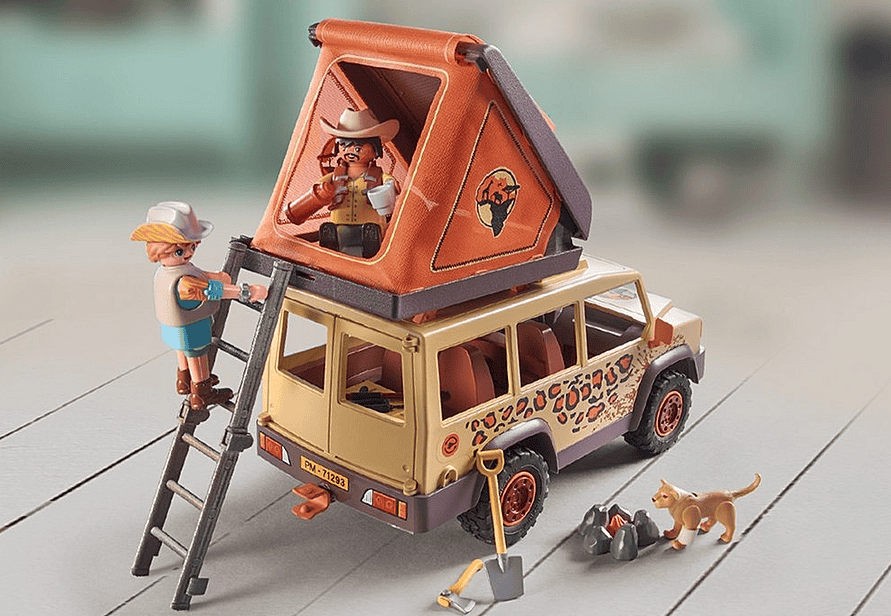
Recycled Playfulness: The Adventure of Reclaimed Plastic Toys
In the spirit of the circular economy, several toy companies are reimagining the life of plastics by creating toys from post-consumer or post-industrial recycled materials.
The Toy Association has launched the ‘Toy Industry Goes Green’ campaign, encouraging companies to innovate with sustainable practices and materials, leading to more recycled and bioplastics toys hitting the market.
These toys not only divert waste from landfills but also serve as an educational tool for parents, demonstrating the infinite ways recycled materials can be repurposed and adding an extra thrill to playtime.
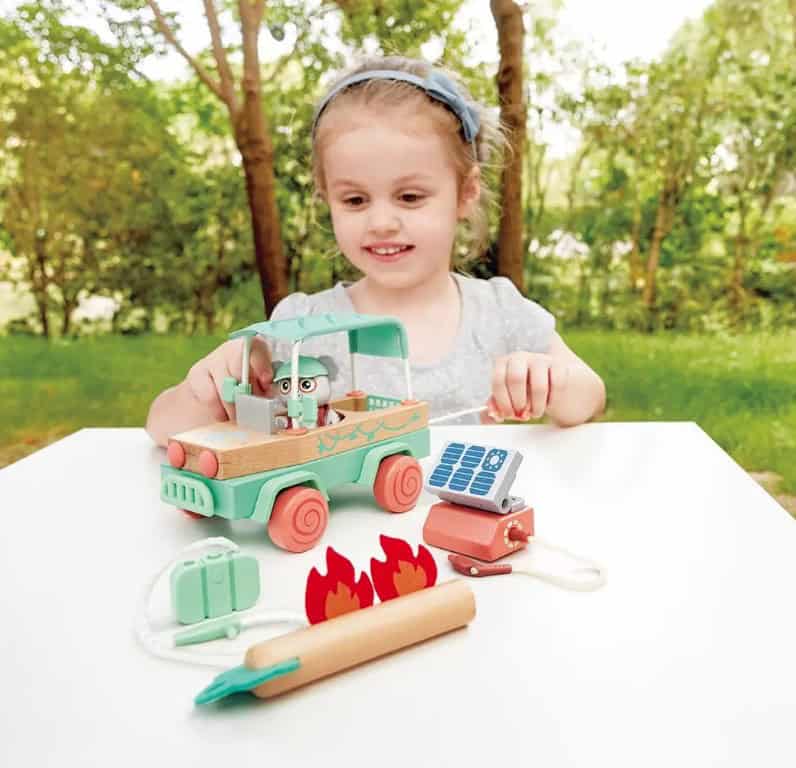
Return to Roots: The Playful Soul of Wooden Toys
Wooden toys have a timeless appeal, a quality that seems to inspire a sense of nostalgia even in those who never owned them. But beyond their aesthetic, wooden toys possess several sustainable advantages.
Durability and Craftsmanship – Carpenters who fashion these playthings often imbue them with the care and skill of an artist. The result is a toy built to withstand not just hours of play, but potentially generations.
Biodegradability – At the end of their long life, wooden toys return to nature seamlessly, breaking down safely without adding harmful chemicals to the environment.
Open-Ended Play – Wooden blocks, trains, and other figures encourage children to create their play, fostering imagination and creativity over passive entertainment.
Wooden toys are not only a nod to the past but a compass for the future of play, reminding us that the simplest materials can provide endless joy while upholding principles of sustainability.
Where It’s Made Matters: The Local Toy Movement
One often overlooked aspect of toy sustainability is its place of manufacture. Toys produced locally have a smaller carbon footprint due to reduced shipping distances and, in many cases, are subject to stricter environmental regulations than those made overseas. The U.S.A., in particular, has seen a resurgence in local toy craftsmanship, blending traditional techniques with innovative designs.
Community Support – Buying locally made toys supports small businesses and local economies, often strengthening communities in the process.
The local toy movement is a celebration of culture, craftsmanship, and care for the environment. It connects the act of playing with stewardship, teaching kids that our choices can have a positive global impact.
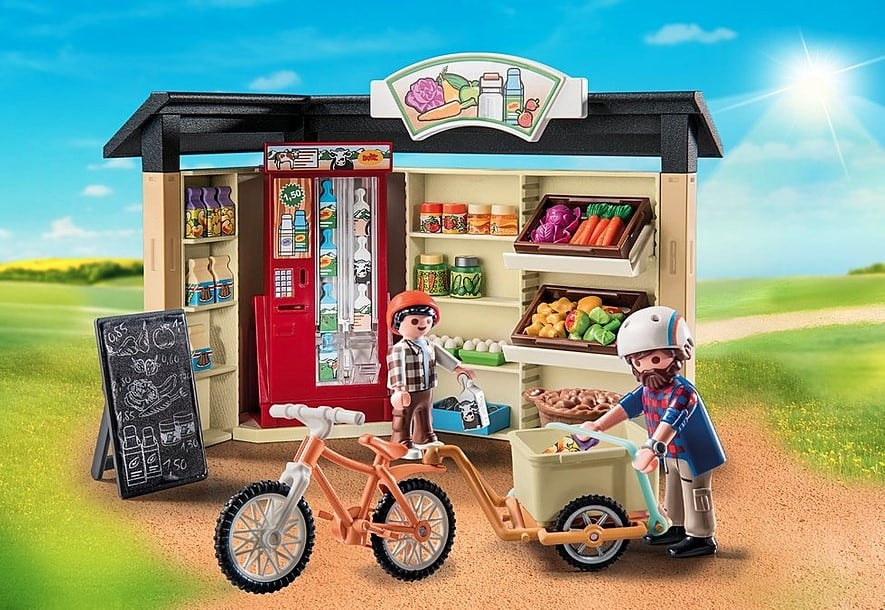
Talking Earth Day with Kids
So, for parents seeking to instill a sense of eco-awareness in their children, Earth Day is an ideal opportunity to start the conversation. Here are some tips for talking about Earth Day with young kids:
Get Visual and Tactile – Engage your child with the world around them. Point out the beauty of nature, and find ways to interact with the environment. This could be clean-up activities or planting.
Use Simple Language and Concepts – Complex issues like climate change can be distilled into accessible terms. Talk about the importance of caring for the planet and the role each person plays in it.
Make It Personal – Relate environmental issues to your child’s experiences. For example, discuss the animals they love or the foods they enjoy. Then, tie them back to the health of the planet.
Lead By Example – Children learn through observation. Model eco-friendly behavior, involving them in household recycling, and reducing waste through various activities.
Earth Day is a reminder that the Earth is not only our home but also the ultimate playground. Sustainable toys offer a playful means to learn about, respect, and care for the environment.
Conclusion
In selecting sustainable toys for our children, we celebrate not only their future but the future of our planet. Finally, look for these toys at your local toy store or on Amazon.

Ellen is a mom of a 25-year-old son and 30-year-old daughter. She is Grandma to one adorable toddler. In what little spare time she has, she loves to read, watch movies, and check out the latest toys and games.
